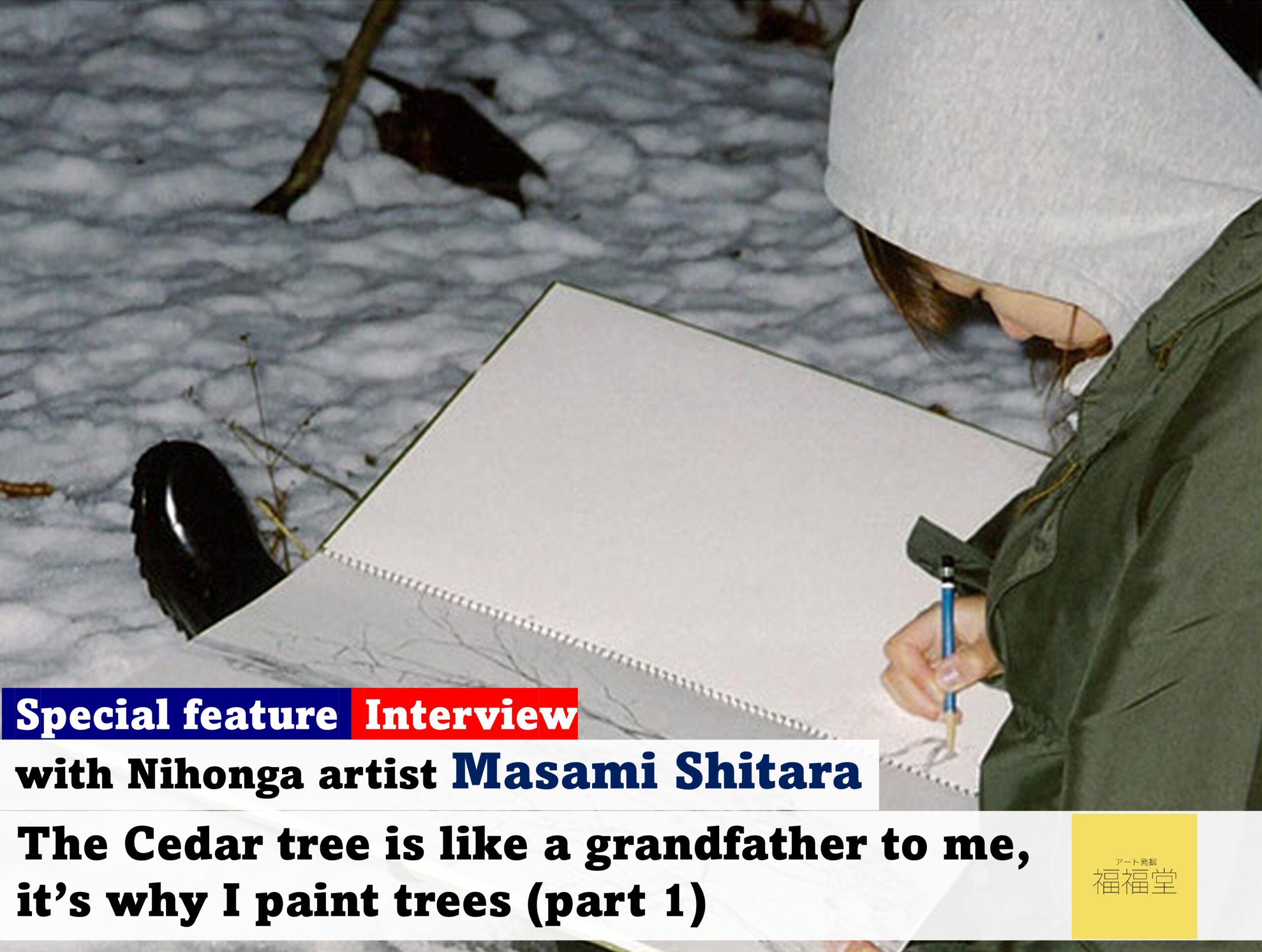
Growing up in Yamagata, Masami was surrounded by trees, which deeply influenced her paintings. Please enjoy reading this interview by the FFD editorial team!
Interview with Nihonga artist Masami Shitara (part 1)
I started drawing thanks to a set of crayons and a sketchbook given to me by my grandfather
Thank you for taking the time for this interview today. What got you into drawing when you were little?
My grandfather gave me a set of crayons and a sketchbook for my birthday, and that was how I fell in love with drawing.
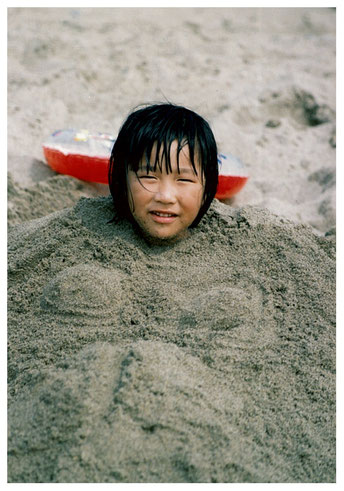
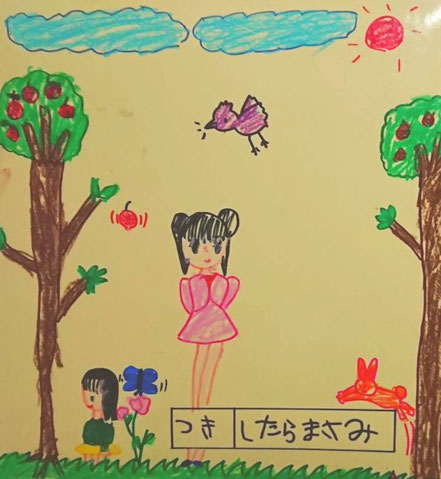
What a lovely gift. What kind of drawings did you do at that early age?
I used to draw little girls in dresses in those days. This one was a drawing of a girl holding a bag in one hand and wearing high heels, a very crude drawing… My grandfather liked to sketch outdoors, so we often went out and sketched together. That’s how I learned the joy of drawing. My home was in the mountain forest, where there were bears and deer. You could see the mountains from right outside our front door, which made a beautiful landscape. I’ve been drawing sceneries such as those since.
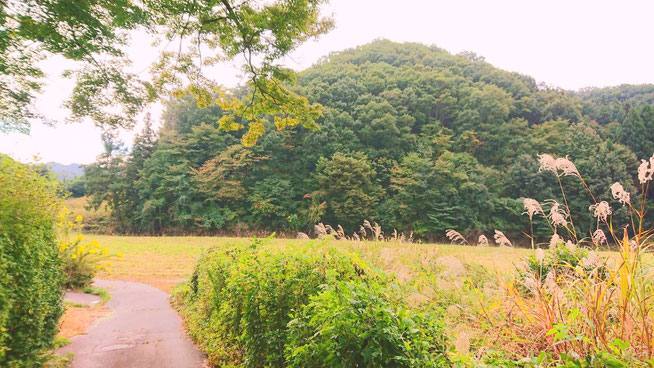
You already had a sense of your current painting style.
Yes, I did. In those days, my grandfather and I would sit together on the grass or stones and draw. If I got bored with landscapes, I would draw animals; rabbits, cats, and so forth.
What a lovely grandchild you are!
I’ve only been talking about my grandfather, but my father also loved to paint.
Oh, your father enjoyed painting too?
Yes, one of my favorite memories was when I was doodling with a pencil on the back of flyers. My father took one of my doodles and printed the picture onto a New Year’s card. It made me even happier to know that he liked what I drew. I think I fell in love with drawing then, which is one of my earliest memories.
Having watched my father painting happily, I started Nihonga
Could you tell me a little bit about when you decided to become a painter?
My father used to do Nihonga paintings. He had to make a living to support his parents, so he couldn’t do it professionally.
Had he aspired to become a Nihonga painter when he was young?
I would guess so. He painted as a hobby while having a day job at an office. He looked so full of life and happy when he was painting. That’s how Nihonga appealed to me, and I vaguely remember thinking then that I wanted to paint in my future.
That experience was what put you on the path of Nihonga.
Yes. As a young child, I used to really enjoy watching my father mix paints on his palette. For me, Nihonga was a natural progression instead of oil paintings. There was never a doubt in my mind.

Nihonga was a familiar art medium for you from an early age. What did your father paint?
He liked to paint landscapes and people. Many of his paintings were a little dark. I don’t know if my paintings are influenced by his, but I use similar colors to his work. I remember he once painted a very distraught looking portrait, as if he wanted to draw people’s attention to it. It wasn’t a painting that I would consider hanging in my house. In our foyer, we have his landscape painting, and I’ve always loved his use of blue in that painting. It’s been hanging there since before I was born, so it’s almost a part of the house to me.
I can understand why it would feel that way.
My father used to paint in his study. Looking back, I think my childhood was surrounded by paintings.
That’s an amazing childhood.
When I talk to painters I know, many of them mention that their own parents were against them going to art school. I was lucky that no one in my family was opposed to me becoming an artist. My father isn’t very active on social media, but he did his best to get on Facebook, and always clicks the ‘like’ button for me.
What a kind and thoughtful father.
I’m so grateful. I wish I could do more for them.
It’s easy to see how you and your parents share the dream of being an artist. I’m sure they’re very proud of you.
I hope so too.
I didn’t fit in at school, and immersed myself in painting
What were your art related activities in school?
I knew I eventually wanted to go to college to study art and painting, so I joined the art club in high school. At the time, I hated school and didn’t really fit in. To escape that, I immersed myself in art and went to an art prep school after school. There were no art prep schools nearby, but I’d heard people say prep school was necessary if you wanted to pass the entrance exam. Every week, I made a two hour commute over to the next prefecture to attend the nearest art prep school. Going on weekly trips to Sendai was not a short trip, but it was the only time I could escape from my grueling reality. Sometimes, I think that if I’d enjoyed my high school life more, I might not have had the urge to become so engrossed in painting and fallen in love with it.
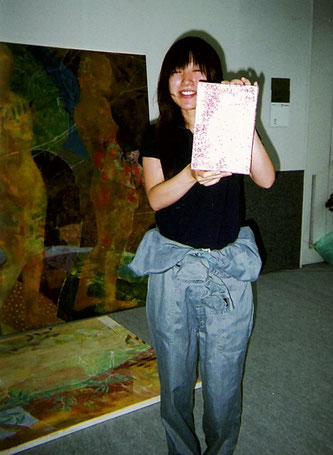
The time spent painting while in high school ended up being helpful for your art.
Looking back, I could see that it helped me. Ultimately, I didn’t pass the entrance exams for any of the art universities I wanted to go to in Tokyo: Musashino Art University, Tama Art University, and Joshibi University of Art and Design. I knew I couldn’t spend another year dedicated to studying for the entrance exams, so I decided to attend a local art college in Yamagata. It wasn’t until after I started college that I seriously began to pursue Nihonga. I studied there for six years, including graduate school.
First entry and first Honorable Mention!
Did you do any exhibitions during college?
I didn’t do any exhibitions while I was attending college in Yamagata, but I submitted my work to public exhibitions. My goal was to become a painter, and I thought winning an award would provide a boost to my artistic biography and portfolio and help me achieve that goal. I remember it was the first time I worked on a large 150-sized painting (2.3m x 1.8m). Through this process, I learned how to complete a painting in my own style and also how to meet deadlines, both of which are common sense today but were skills that I needed to learn.
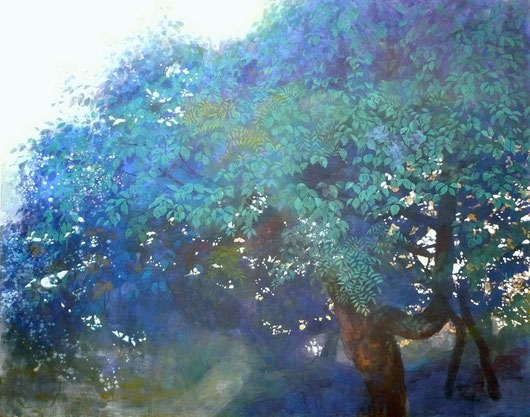
How did you do at the public exhibition?
My work got selected for an honorable mention in the first exhibition I applied to, which was very fortunate. Having grown up in the countryside, I was moved to see my painting displayed at the Tokyo Metropolitan Art Museum. The public exhibition is called Sogakai, which I entered once during my senior year, and once more the year after I graduated. That was the first time that I had taken on a challenge and achieved my goal. It helped me shift my dream of becoming an artist from an abstract dream to a more concrete and achievable goal.
Do you know where that large painting is currently hung?
It’s still in my childhood home. My large painting is completely blocking one of the hallways.

Did you move to Tokyo right after you graduated?
Yes, I knew that the best way to have people get to know my work was to hold a solo exhibition. I thought it would be better for me to go to Tokyo to attend and learn from other artists’ exhibitions there.
(Interviewer, FFD editorial team)
Artist Masami Shitara bio, awards, and exhibitions

1984 Born in Tendo, Yamagata
2009 Completed Nihonga Research Field, Tohoku University of Art & Design, Graduate School of Culture and the Arts
2012
Group exhibition, Hokuto Shichisei (The Big Dipper) Exhibition, Art Space Rashinban, Tokyo
Trio exhibition, Ashita eno Tegami (Letters for tomorrow) Touring Exhibition, Gallery re:tail, Tokyo, To-o-no Kura-no-michi Gallery, Iwate (May), Build Space, Miyagi (June)
Group exhibition, Tobi-no-kai, Sato Art Museum, Tokyo
2015
Group Exhibition Tobi-no-kai, Inoue Gallery, KAMIYA-ART, Tokyo
2019
Participated in “Artists Living Here and Now 2019”, Gallery Echo-ann, Tokyo (2013, 2015, 2017)
Group exhibition, Art Sekigahara, Fukuya Hatchobori Main Building, Hiroshima
2020
Group exhibition, Neo-Naive group exhibition, Hanshin Umeda Main Building, Osaka
EGC Exhibition, Hanshin Umeda Main Building, Osaka
2021
EGC Select Exhibition, Hanshin Umeda Main Building, Osaka
EGC Exhibition, Fukuya Hatchobori Main Building, Hiroshima
Grand EGC Exhibition, Hilltopia Art Square, Tokyo
Duo Exhibition “Masami Shitara and Ayaka Matsuo – Young Artists Exhibition ~ Hikari, Komorebi and Shizuku~”, Fukuya Hatchobori Main Building, Hiroshima
2022
EGC Exhibition, Fukuya Hatchobori Main Building, Hiroshima
Grand EGC Exhibition, Hanshin Umeda Main Building, Osaka
2010
Solo Exhibition Masami Shitara Exhibition, Ginza Yuu Gallery, Tokyo
2011
Solo Exhibition Masami Shitara Exhibition, Ginza O Gallery UP-S, Tokyo
2013
Solo Exhibition Masami Shitara Exhibition, Etsuko Shibata Gallery, Tokyo
2022
Solo Exhibition Masami Shitara Nihonga Exhibition ~Kigi no Sazameki (The Rustle of the Trees)~, Yamaguchi Izutsuya, Yamaguchi
Solo Exhibition Masami Shitara Nihonga Exhibition ~Kaze no Sazameki (The Rustle of the Wind)~, Kokura Izutsuya, Fukuoka
2006
The 33rd Soga Exhibition, Honorable Mention, exhibited at the Tokyo Metropolitan Art Museum, Tokyo, (Honorable Mention in 2007, 2011)
2008
The 34th Spring Soga Exhibition, Honorable Mention, exhibited at the Nihonbashi Takashimaya Department Store, Tokyo, (Honorable Mention in 2010)
The 26th The Ueno Royal Museum, Grand Prize Exhibition, The Ueno Royal Museum, Tokyo
Description of Masami Shitara’s work Soyokaze no Oto (The Sound of the Breeze)
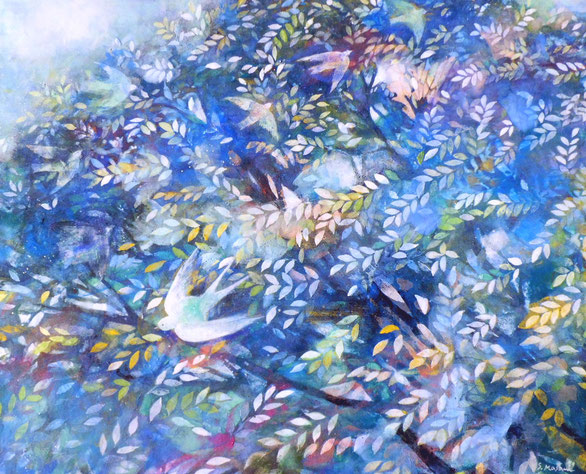
The artist grew up around and has been painting Keyaki (Japanese Zelkova) trees her whole life, since being born in Yamagata. “With the pandemic, I couldn’t return to my hometown very often. I came across a large keyaki in a park in Saitama, where I went to play with my niece. It gave me a sense of peace and clarity. The park is nowhere near the same as the vast, untouched, almost mystical and rugged natural environment in my hometown of Yamagata, but it was a peaceful zelkova tree where I could feel the human life nearby.”
Keyaki trees stretch their branches leisurely in the sky. The leaves rustle in the wind. It’s a work of art that purifies one’s mind. The artist, who grew up talking to the trees in the mountains, says that the trees have a grandfatherly connection to her. The pictures of trees drawn by the artist tell us more than meets the eye.
(description by FFD editorial team)
Details of Masami Shitara’s exhibition
Masami Shitara: Japanese Painting Solo Exhibition
2025.1.8-13
Venue: Yamaguchi Izutsuya 5F Art Gallery
Admission free